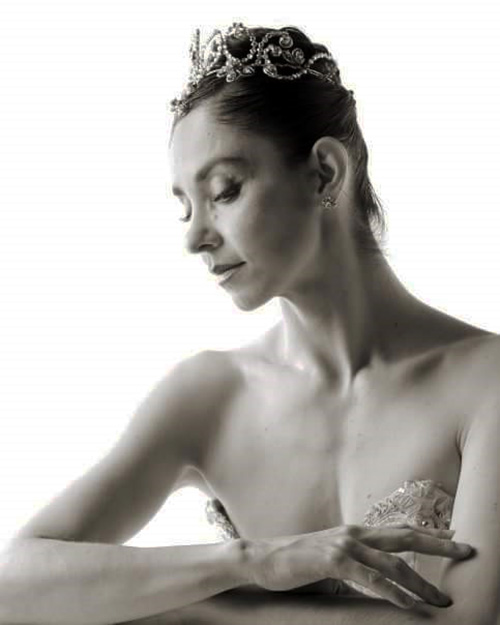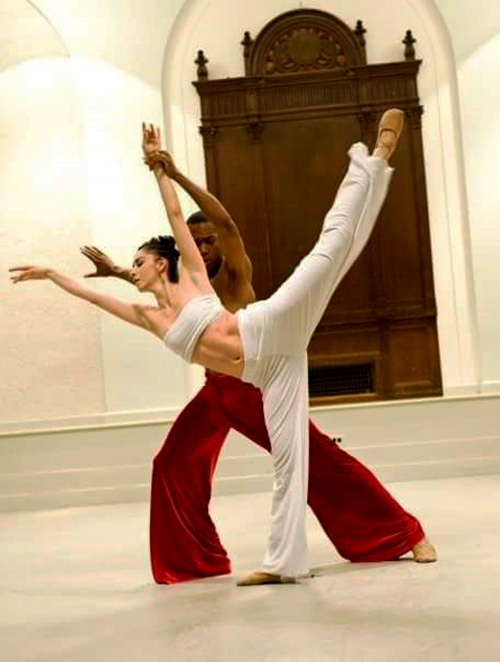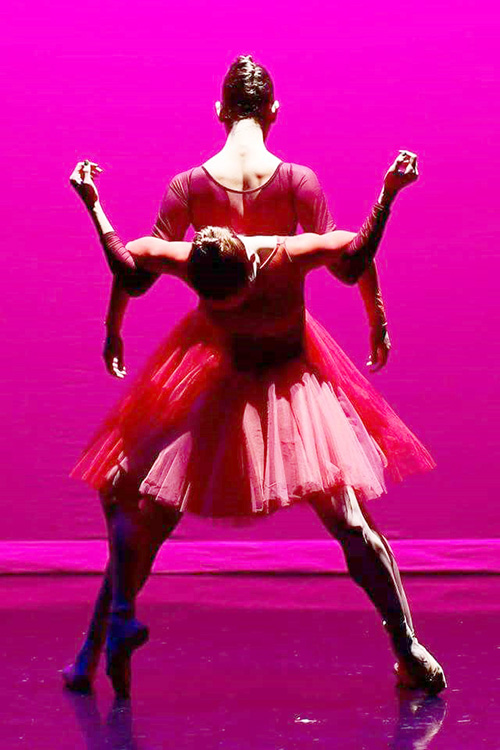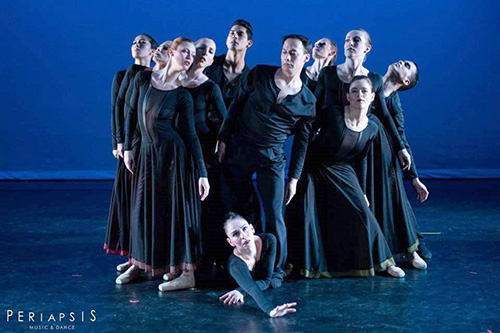Drawing on Many Resources
An Interview with Ursula Verduzco
BY EMMALY WIEDERHOLT
Ursula Verduzco started dancing in her native Mexico, and continues to perform, choreograph and teach in New York City today. As part of a special dialogue in honor of National Hispanic Heritage Month, this ballerina shares a bit about her creative process, accessing the value of her culture, and how we can expand diversity in dance.
Ursula Versuzco; photo by Rachel Neville
~~
When you’re choreographing, do you work from a political, social or personal place, or a mix?
It varies depending on where I am in my life. My work – both dancing and choreography – comes from a personal space. Even if I want to say something political or social, it comes from a place I care about. In that sense, I take a personal approach.
In general, my choreography comes from images in my head. Sometimes I don’t have something to say, but I have an image of, for example, a tree and a woman standing under it, that I’ll start to explore. Eventually I find a piece of music that fits the image in my head. From there, I start to bridge the image and music with maybe a story I’ve heard, an experience I’ve had, or something happening in the world. I’m very visual, so I like to work with costumes and lighting in addition to the movement. I piece all these segments – which I call emotions, since they have an emotional quality – together, and eventually I create something. That’s generally my choreographic process.
My background is in ballet. After performing classical ballet for many years, I’ve started to transition into contemporary ballet. I still often use pointe shoes, but I embrace freer movement. Both as a dancer and choreographer, I’m trying to experience different possibilities.
Is it important to you to be recognized as a Hispanic/Latina or female choreographer, or do you see the modifiers as a form of tokenism?
It’s an interesting question. I’ve been able to use to my advantage the fact that I am of Hispanic descent and that I am a woman. I’ve applied to residencies and grants specifically supporting female or Hispanic choreographers. I believe those opportunities have helped me. At the same time, the label is not something I’m looking for. While there is a need to support Hispanic and women choreographers, I don’t think we should stop at those labels, because we’re more than those labels. I’m not just a Latin choreographer, and my work is not necessarily based on the fact I’m Mexican, even though it certainly informs it. I bring who I am into what I do and create. It’s an interesting question; I don’t want to be labeled, but I also think it’s important to provide opportunities. The only way female Hispanic choreographers get opportunities is by saying, “We are women, and we are Hispanic.” It’s hard to find the middle ground.
Photo by Rachel Neville
In your experience, do you feel there are enough opportunities for Hispanic dance artists, or would you like to see more?
No, I don’t think there are enough opportunities. I would like to see more options for people who are of different backgrounds. We are talking about people of Hispanic/Latino/Chicano descent but, in general, there needs to be more support for all different voices. It’s starting to happen, but I don’t think it will continue if we don’t push for it. Especially right now, we are in a moment in our country’s history when we need to support each other as a community – not only as a dance community, but as a Hispanic community – and there are many places where that’s happening. However, the degree of support needs to be more.
I also think it’s easy to get stuck in the world of being a female choreographer or Latin choreographer. It’s easy to just take opportunities that are presented by organizations that promote those identities. It’s important as an artist to push for opportunities from many sources, not just wait for opportunities to be provided.
What are some changes you’d like to see that would create better representation of Hispanic/Latina voices?
Finding a way to value what we have to offer is one way my community could find more support. We have immense cultural resources. Just look at the heritages of the Hispanic/Latino/Chicano communities. People who are not of that heritage like to experience it; they like to visit those countries and spend money in those places. But when they come back to the states, that experience doesn’t seem valuable in everyday life. How can we figure out a way to continue to bring our culture to the table in an enriching and valuable way?
Do you feel like your Mexican heritage has ever felt incongruous with your ballet training, especially given ballet’s problematic relationship with body type?
I started training in Mexico when I was four years old. At the time, the stereotypical ballerina in Mexico was definitely not me. I am long and, at that time, the stereotype was petite and slender. Being a tall dancer was a problem. When I came to the states, my height was an advantage. Here, people are physically taller, and the stereotypical ballet dancer in America was taller than the stereotypical ballet dancer in Mexico. I find it frustrating that you can spend your life trying to be something else, and in one place you’re perfect, and in another place you’re not. However, it can all change in a matter of years if the fashion changes or if your body changes.
Photo by Eduardo Patino
Stereotypes are everywhere. The fact that my background is in ballet doesn’t mean it’s the only style of dance that has stereotypes. Transitioning from classical to contemporary ballet, I feel like I’m in limbo. In contemporary auditions, I’m too classical and, in ballet auditions, I’m not balletic enough anymore. What I’ve learned in the past few years is that you have to push to be the best body and artist you can be. You will have rejections, and you will receive opportunities, but you just have to make the best of it.
We’re in a society that is totally based on image. It’s no wonder the dance world plays into that.
What do you hope is your contribution to the dance world?
I want to continue to perform; it’s very important to me to stay active as a dancer. I have a specific need to perform and experience the world of whomever is creating that world for me. However, choreography has been an amazing gift. It came at a moment when I really needed to say something, and it has rolled forward by itself. I love to create my own worlds. As I move forward, I think dancing and choreographing will come together. I’ve been very fortunate; I was asked to dance some of my solo work in Cuba and Mexico, which opened possibilities for me. Right now, I’m trying to commission the work of people I like so I can build a repertoire. I don’t just want to be a dancer or a choreographer. I can be very fulfilled by doing both. How they come together, time will tell.
Any other thoughts?
In general, the dance world is about becoming someone – either through technical proficiency or a company contract – and, as a result, we lose a lot of the reason why we started dancing in the first place. We are in this field because we love movement and have a special sensitivity. We have images in our heads and the desire to say something through movement. I would like to see the dance world become more inclusive, not just in terms of diversity, but through all the things we can bring to dance. I’ve noticed that dancers, in general, don’t read very much, or go to museums, or stay informed politically. We seem to get tunnel vision as a result of our training. There is so much more to dance beyond the technical aspect. I’d love to see the artistic side become more prominent. I believe it was at one time, and I believe it’s our responsibility to bring it back.
Photo by Rachel Neville
~~
To learn more, visit www.ursulaverduzco.com.





2 Responses to “Drawing on Many Resources”
Thanks for reading and commenting Tanya! Ursula was a pleasure to include on Stance on Dance!
Thank you for sharing this! I have both worked with Ursula as well as had the pleasure to watch her work from the audience perspective, and she certainly brings a lot of passion and emotion to the dance world. It’s great reading more of her story!
Comments are closed.